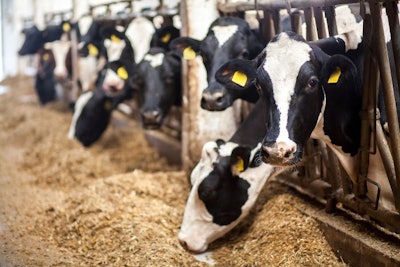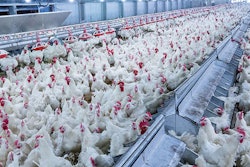
One of the most persistent concerns in the minds of all dairy farmers is the issue of acidosis and bloating.
All ruminant animals fed with a high level of grains are susceptible to these metabolic conditions. Indeed, young beef cattle raised intensively, reaching exceptional weights at very young ages, suffer as frequently as high-yielding dairy cows from these same disorders.
The rumen in cattle is organized to transform roughage (high-fiber) material, of naturally low nutritive value, into high-value products, namely volatile fatty acids (energy) and microbial mass (proteins and vitamins). This is how, in nature, ruminant animals can cope even in arid areas with scarce or no lush vegetation. But, in intensive farming systems, we must load the rumen with more readily available forms of energy (cereals) and proteins (such as soybean meal) in order to derive the high milk yields we need to remain profitable in a low-margin industry.
Naturally, when grains prevail over roughages in the rumen, microbes that degrade fiber tend to die out in favor of others that thrive on starch and proteins. These different microbes, when they reach an excessive level, induce so much acidity that they make the rumen hostile to further microbial growth, especially for fibrolytic strains. That is, in very general terms, what we call acidosis, which leads to rumen shutdown and a host of other problems that can include even pathological symptoms.
And, on top of that, these bacteria that utilize grains so well produce too many gases, exceeding the animal’s capacity of getting rid of them. As such, the gases accumulate and cause bloating that is a very visible distress symptom that needs immediate attention as it can threaten the life of the animal. Other conditions, and even some specific roughages, contribute to bloating, but here we examine the role of high-grain diets into the combined problem of acidosis and bloating.
What can be done to prevent these two symptoms? Here, we need to discuss the issue of prevention, not only because it is preferable to a cure, but because the latter often requires the collaboration of a veterinarian, and as such it is a totally different discussion. The following seven steps can prevent or reduce the incidences of acidosis and/or bloating, at least in some degree, because we cannot cheat nature for too long.
1. Sodium bicarbonate
Adding some sodium carbonate (an alkali, or anti-acidic compound) that, when in water solution – in the rumen – releases hydroxide anions that neutralize hydrogen cations, brings rumen acidity (pH) closer to neutral (7). There are two problems with this approach: First, adding too much sodium carbonate adds too much sodium in the diet and nothing in excess is a good thing; second, too much carbonate can cause excessive bloating (the soda effect in soft drinks.) Thus, there is a limit to how much of this ingredient can be added. The same is true for potassium bicarbonate, which is not so widely used.
2. Magnesium oxide
This is a direct antacid that rapidly increases alkalinity and prevents acidosis. Its problem is that it can be too effective, risking alkalosis – the opposite of acidosis – with its own problems. Thus, this too has limits on how much can be included in a dairy ration. In fact, it is a blend of sodium bicarbonate and magnesium oxide that is used most often.
3. Yeast
Whether dead or alive or fragmented, a small amount of yeast can help ruminants sustain a healthier rumen ecology, meaning a more robust fybrolytic bacterial population that is not easily affected by a high-grain diet. Again, the exact mechanism of how yeast helps the animal is unknown, but the general consensus is that it helps to some degree.
4. Roughage stem length
Cows that graze chop long swaths of grass and gulp them down without any chewing. They leave this job for when they rest, during which time they “ruminate.” That is, they bring up from the rumen a bolus of roughage and chew it. During this time, they produce saliva, which includes a lot of natural bicarbonate that helps reduce rumen acidity. If we provide stabled dairy cows with finely chopped roughage material (because it is easier to mechanize its distribution), we disrupt this natural process, and then we have to add chemicals to bring rumen pH back to normal. Thus, long roughage is a natural way for the animal to avoid metabolic rumen distress problems.
5. Grain particle size
Finely ground grains are required for non-ruminant animals (pigs and poultry) to improve feed efficiency. The same can be said for ruminants, as finely ground grains can rapidly escape the rumen and reach the real stomach, providing more readily available energy and proteins. But this also creates a target for bacteria in the rumen, leading eventually to acidosis and bloating. Thus, there needs to be a balance between how finely we grind grains and the risk of metabolic disorders.
6. Pelleted ingredients
Some feedstuffs come pelleted – sugar beet pulp and rapeseed meal are two that come easily to mind. If acidosis is a problem, it would be wise to avoid grinding them down before incorporating into rations. Perhaps this will cause a bit of a mechanical/distribution problem for large dairy farms, but letting cows do the grinding themselves (chew them down to size) will work as with long-stemmed roughage: more saliva equals more bicarbonate in the rumen.
7. Frequent meals
A large, single meal is a sure way to induce acidosis in high-yielding dairy cows. The rumen expects a daylong, gradual introduction of material to function properly. Breaking meals down into more portions, offered especially during the cooler hours of the day, will help the rumen retain its health and functionality, always with the additional help of the above measures. Again, offering too many meals may be impractical, but it is preferable to the alternative: a non-producing cow.
All of the above are tools that require a technician (manager) to use as deemed appropriate. Acidosis and bloating can and do exist even in subclinical forms – that is, without obvious, external symptoms other than a drop in productivity. An on-site manager, with the help of a qualified nutritionist, can determine what non-nutritional measures and nutritional interventions can be taken to bring down these metabolic disorders to a level where productivity ensures profitability and animal health and welfare.

















